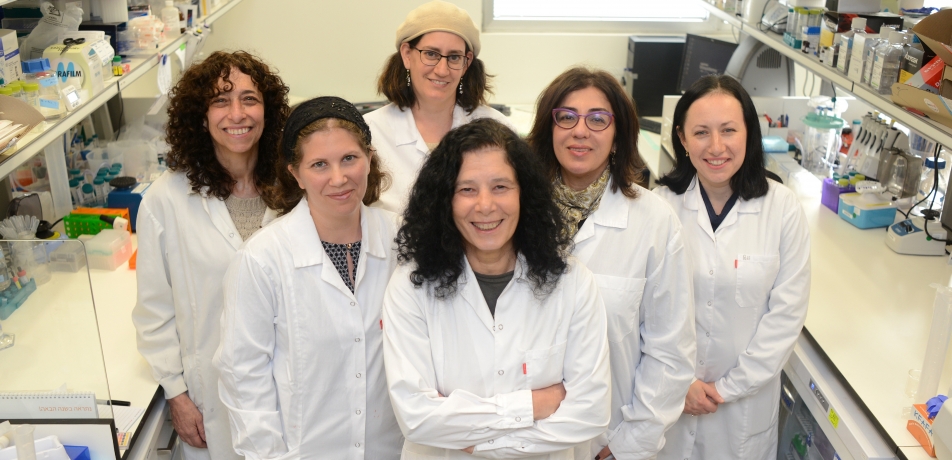The matrix modifier
Could fixing the cell’s support system hold promise for disease?
Briefs

Team MabTrix: L-R: Dr. Daphna Miron, Dr. Moran Grossman, Dr. Dorit Landstein, Prof. Irit Sagi, Dr. Polina Toidman-Rabinovich. At back: Navah Figov.
A new biotech start-up is trying to restore the cell’s support system and in doing so, offer a solution for patients suffering from inflammatory bowel disease, or IBD.
In such conditions, like Crohn’s disease and ulcerative colitis, the immune system mistakenly attacks the body’s tissues—and the result is often debilitating, with patients suffering over their entire lifetime. In 2012, Prof. Irit Sagi of the Department of Biological Regulation and her lab team made a key discovery that infused promise into the treatment of these diseases. Since then, the discovery was patented and licensed to a start-up company, MabTrix, whose singular task is to further develop the breakthrough and bring it to a critical point at which a major investor or pharmaceutical company can make it commercially viable.
The company is one of over a dozen biotech start-ups under development in the FutuRx accelerator in Nes Ziona, near the Weizmann Institute. At FutuRx, companies receive an investment and are offered an infrastructure for early-stage innovation—i.e., lab space, personnel, management expertise, and more—for a period of three years. MabTrix, led by CEO Dr. Dorit Landstein, is nearing the end of its incubation period and has achieved a more-defined antibody for treating IBD and cancer.
Why a matrix matters
The discovery that became the basis of MabTrix had its origins in Prof. Sagi’s longtime interest in the structural and biochemical support system of cells, called the extracellular matrix. These components are involved in a vast number of normal physiological processes—from embryonic development and reproduction to bone development, wound healing, and blood vessel development. When something goes wrong in these matrices, the implications can be ominous. In fact, they appear to be a major factor underlying IBD.
More than a decade ago, Prof. Sagi began looking for ways to home in on and manipulate members of a family of enzymes, called MMPs, that work to remodel the extracellular matrix. What interested her was how, when MMPs—and in particular MMP9—get out of control, they can aid and abet autoimmune disease and cancer. Finding a way to block these proteins, she understood, might lead to effective treatments for a number of diseases.
It was a novel way of looking at the scaffolding around cells—and how they malfunction. Few scientists had ever focused on this particular enzyme, and Prof. Sagi and her group felt that there might be uncharted and promising territory ahead. Aware that the body has a natural blocker to MMP9, they set out to find something similar: an antibody, that could keep MMP9 in check. Her 2012 publication in Nature Medicine made major waves in the field when it described how her lab had managed to trick the immune systems of mice into creating natural antibodies targeting MMP9 through an immunization.
“By injecting a complex that mimics the heart of MMP9 into mice, we could isolate an antibody with protective response that kept MMP9 in check,” says Prof. Sagi. In time, aware of the promise of the breakthrough, the Weizmann Institute’s technology transfer arm, Yeda, ushered the discovery into the preclinical stage with the establishment of MabTrix.
About three million people suffer from IBD in the United States alone. As CEO of MabTrix, Dr. Landstein’s job is to both refine the science and interest investors who would be able to invest the sums necessary for preclinical development and to perform clinical trials in patients who suffer from IBD. Its utility in cancer, which also involves the degradation of the extracellular matrix, could also be studied.
Refining the science
“I have been focusing on development of therapeutic antibodies for many years,” says Dr. Landstein, who has played key roles in other start-ups in the same field. “But when I heard about this discovery, I got excited about the potential and we think it could have a real beneficial impact for many patients.”
When she started in 2015, her first task was to recruit just the right mix of professionals. Among MabTrix’s small team of scientists is Dr. Moran Grossman, who earned her PhD in Prof. Sagi’s lab. Dr. Grossman is helping optimize the technology that was identified in her mentor’s lab, for generating function-blocking therapeutic monoclonal antibodies that specifically inhibit the activity of MMP9.
“Understanding the history of the research process on MMP9, and now working on refining it, alongside this team, is thrilling,” says Dr. Grossman. “What is clear is that true breakthroughs start at the level of basic research.”
Prof. Irit Sagi is supported by Cynthia and Andrew Adelson, the The Azrieli Foundation, the Leonard and Carol Berall Postdoctoral Fellowship for Research on Autoimmune Diseases Including Crohn's, the European Research Council, The Helen and Martin Kimmel Institute for Stem Cell Research, The Moross Integrated Cancer Center, the Rising Tide Foundation, John Rose, the Spencer Charitable Fund, Leesa Steinberg, and Murray and Murielle Steinberg Crohn’s Research Fund. Prof. Sagi is the incumbent of the Maurizio Pontecorvo Professorial Chair.








